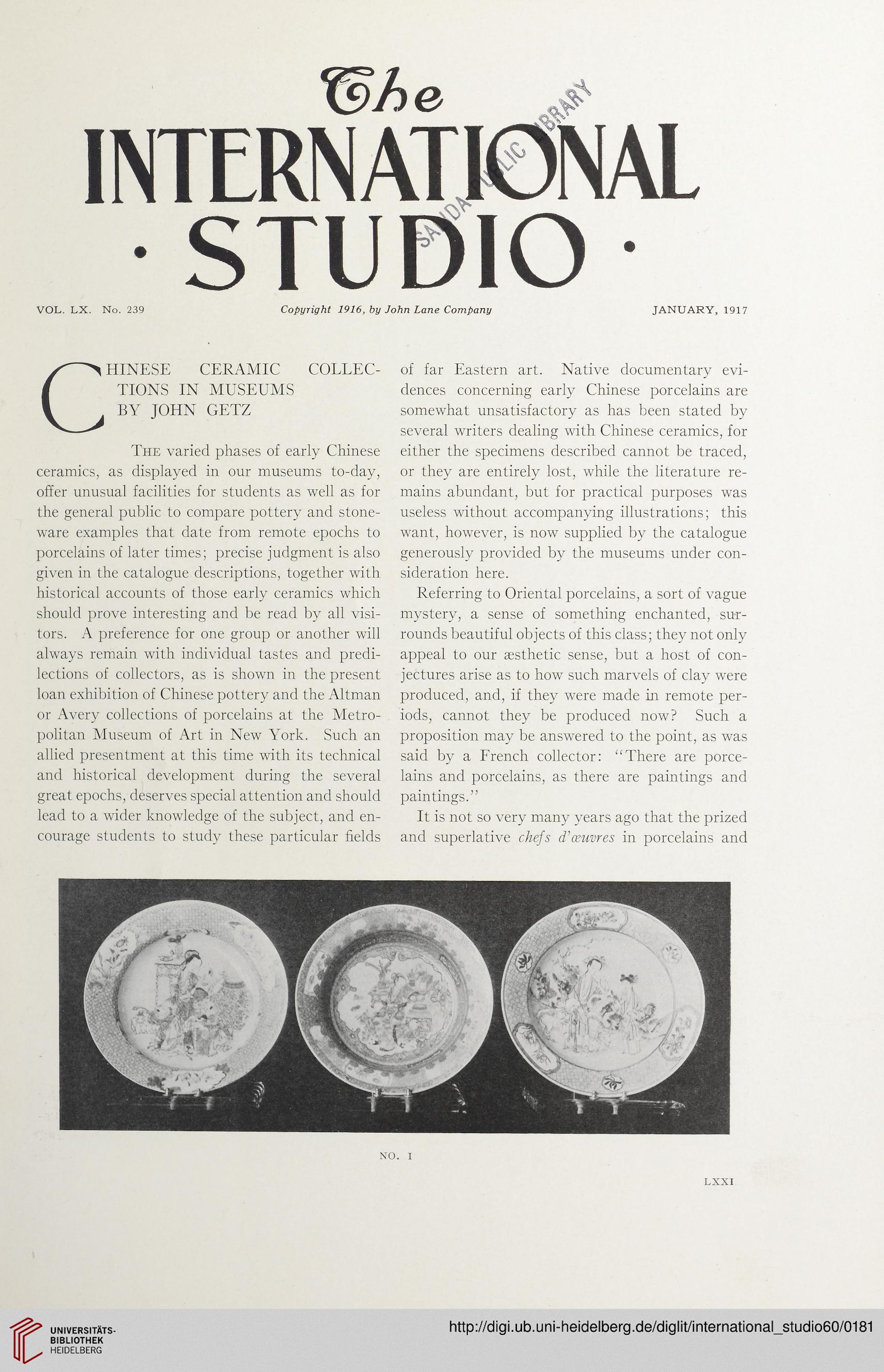Copyright 1916, by John Lane Company
JANUARY, 1917
VOL. LX. No. 239
INTERNATIONAL
• STUDIO
CHINESE CERAMIC COLLEC-
TIONS IN MUSEUMS
BY JOHN GETZ
The varied phases of early Chinese
ceramics, as displayed in our museums to-day,
offer unusual facilities for students as well as for
the general public to compare pottery and stone-
ware examples that date from remote epochs to
porcelains of later times; precise judgment is also
given in the catalogue descriptions, together with
historical accounts of those early ceramics which
should prove interesting and be read by all visi-
tors. A preference for one group or another will
always remain with individual tastes and predi-
lections of collectors, as is shown in the present
loan exhibition of Chinese pottery and the Altman
or Avery collections of porcelains at the Metro-
politan Museum of Art in New York. Such an
allied presentment at this time with its technical
and historical development during the several
great epochs, deserves special attention and should
lead to a wider knowledge of the subject, and en-
courage students to study these particular fields
of far Eastern art. Native documentary evi-
dences concerning early Chinese porcelains are
somewhat unsatisfactory as has been stated by
several writers dealing with Chinese ceramics, for
either the specimens described cannot be traced,
or they are entirely lost, while the literature re-
mains abundant, but for practical purposes was
useless without accompanying illustrations; this
want, however, is now supplied by the catalogue
generously provided by the museums under con-
sideration here.
Referring to Oriental porcelains, a sort of vague
mystery, a sense of something enchanted, sur-
rounds beautiful objects of this class; they not only
appeal to our aesthetic sense, but a host of con-
jectures arise as to how such marvels of clay were
produced, and, if they were made in remote per-
iods, cannot they be produced now? Such a
proposition may be answered to the point, as was
said by a French collector: “There are porce-
lains and porcelains, as there are paintings and
paintings.”
It is not so very many years ago that the prized
and superlative chefs d’oeuvres in porcelains and
NO. I
LXXI
JANUARY, 1917
VOL. LX. No. 239
INTERNATIONAL
• STUDIO
CHINESE CERAMIC COLLEC-
TIONS IN MUSEUMS
BY JOHN GETZ
The varied phases of early Chinese
ceramics, as displayed in our museums to-day,
offer unusual facilities for students as well as for
the general public to compare pottery and stone-
ware examples that date from remote epochs to
porcelains of later times; precise judgment is also
given in the catalogue descriptions, together with
historical accounts of those early ceramics which
should prove interesting and be read by all visi-
tors. A preference for one group or another will
always remain with individual tastes and predi-
lections of collectors, as is shown in the present
loan exhibition of Chinese pottery and the Altman
or Avery collections of porcelains at the Metro-
politan Museum of Art in New York. Such an
allied presentment at this time with its technical
and historical development during the several
great epochs, deserves special attention and should
lead to a wider knowledge of the subject, and en-
courage students to study these particular fields
of far Eastern art. Native documentary evi-
dences concerning early Chinese porcelains are
somewhat unsatisfactory as has been stated by
several writers dealing with Chinese ceramics, for
either the specimens described cannot be traced,
or they are entirely lost, while the literature re-
mains abundant, but for practical purposes was
useless without accompanying illustrations; this
want, however, is now supplied by the catalogue
generously provided by the museums under con-
sideration here.
Referring to Oriental porcelains, a sort of vague
mystery, a sense of something enchanted, sur-
rounds beautiful objects of this class; they not only
appeal to our aesthetic sense, but a host of con-
jectures arise as to how such marvels of clay were
produced, and, if they were made in remote per-
iods, cannot they be produced now? Such a
proposition may be answered to the point, as was
said by a French collector: “There are porce-
lains and porcelains, as there are paintings and
paintings.”
It is not so very many years ago that the prized
and superlative chefs d’oeuvres in porcelains and
NO. I
LXXI




